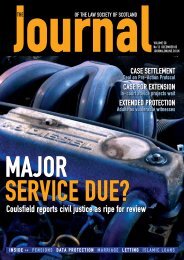OF THE LAW SOCIETY OF SCOTLAND - The Journal Online
OF THE LAW SOCIETY OF SCOTLAND - The Journal Online
OF THE LAW SOCIETY OF SCOTLAND - The Journal Online
Create successful ePaper yourself
Turn your PDF publications into a flip-book with our unique Google optimized e-Paper software.
Finding,<br />
Keeping,<br />
Sending<br />
<strong>Journal</strong><br />
IT<br />
It’s becoming increasingly common for fee-earners to have computers on their desks.<br />
Unfortunately, few firms bother spending much money on training lawyers how to use them properly.<br />
Scott Cownie illustrates some common techniques in making Internet Explorer and Outlook talk to each other<br />
Many primary materials are now<br />
available on the Internet. <strong>The</strong><br />
Scottish Courts website at<br />
www.scotcourts.gov.uk is one<br />
example. Practically all Supreme<br />
Court decisions and some Sheriff<br />
Court decisions are published on it,<br />
usually within a day or two, and<br />
certainly sooner than printed case<br />
reports. Being able to see decisions<br />
as soon as they are issued is one<br />
thing, but to get value out of it, you<br />
need to know how to manipulate<br />
the information. <strong>The</strong>re is a slight<br />
problem with the structure of the<br />
scotcourts site, stemming from its<br />
use of HTML frames to organise<br />
the layout of the site. This makes<br />
some processes less intuitive than<br />
with other sites.<strong>The</strong>re are, however,<br />
some simple work-arounds, and<br />
these may be worth learning as<br />
they can be used to resolve the<br />
frames problem which occurs in<br />
several “official” sites.<br />
Here’s how to:<br />
■ Set the “Supreme Court<br />
structured search” page as a<br />
“favorite”.<br />
■ Save particular cases to your<br />
machine.<br />
■ Attach the case to an e-mail.<br />
Setting “favorites”<br />
You’ll be familiar with the structure<br />
of a typical website address, in this<br />
example, www.scotcourts.gov.uk.<br />
This address is associated with a<br />
particular piece of space on a<br />
server, a server being a computer<br />
which is programmed to “serve” up<br />
pages when requested by someone<br />
like you through an Internet<br />
browser, such as Internet Explorer.<br />
<strong>The</strong> space contains a series of<br />
pages, usually organised within a set<br />
of directories. Later on, I’ll be<br />
looking at an address within the<br />
scotcourts site called<br />
www.scotcourts.gov.uk/cgibin/Supreme.pl,<br />
where<br />
scotcourts.gov.uk is the space on<br />
the server, cgi-bin is a directory<br />
within that space and Supreme.pl is<br />
a file within that directory. If this<br />
seems abstract, think filing cabinet /<br />
folder / letter.<br />
It’s easy to set a particular site as a<br />
“favorite” by clicking Favorites | Add<br />
to Favorites… from the menu bar<br />
at the top of the browser screen.<br />
This pops up a dialog box, which<br />
allows you to add that particular<br />
page to your list of Favorites, and<br />
you can then return to that page in<br />
the future by clicking the favorites<br />
icon in the browser to show your<br />
list and then clicking the site title in<br />
the list, saving you from having to<br />
remember the address.<br />
41 May 2002 Volume 47 No 5










